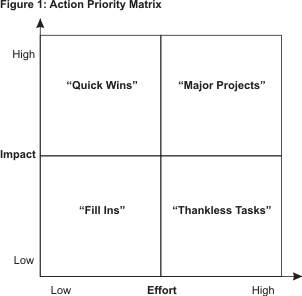The Action Priority Matrix
Making the very most of your opportunities
The Action Priority Matrix is a simple diagramming technique that helps you choose which activities to prioritize (and which ones you should drop) if you want to make the most of your time and opportunities.
It’s useful because most of us have many more activities on our “wish lists” – whether these are bright ideas to pursue, exciting opportunities or interesting possibilities – than we have time available. By choosing activities intelligently, you can make the very most of your time and opportunities.
However by choosing badly, you can quickly bog yourself down in low-yield, time-consuming projects that close down opportunities and stop you moving forwards.
How to Use the Tool:
Figure 1 below shows the basic form of the Action Priority Matrix:

The principle behind using the tool is that you score each activity you want to complete on two scales – firstly on the impact the activity will have, and secondly on the effort involved.
By plotting each activity on the Action Priority Matrix using these scores, you can quickly see the projects that give you the greatest returns on your efforts; and adopt the most appropriate approach for that type of activity:
Quick Wins (High Impact, Low Effort): These are the most attractive projects, giving you a good return for relatively little effort. Focus on these as much as you can;
- Major Projects (High Impact, High Effort): While these give good returns, they take a long time to complete – meaning that one “Major Project” can crowd out many “Quick Wins”. If you’re engaging in these, make sure that you complete them quickly and efficiently and that you disengage your effort as soon as you can;
- Fill Ins (Low Impact, Low Effort): Don’t worry too much about doing these – if you’ve got spare time, do them, but drop them if something better comes along; and
- Hard Slogs (Low Impact, High Effort): Avoid these. Not only do they give low returns, they crowd out time which would be better used elsewhere.
Tip 1: |
To use the Action Priority Matrix, print off our free worksheet and then follow these steps:
List the activities that you’d like to complete;
- Score them on impact (from, say, 0 for no impact to 10 for maximum impact) and on effort involved (from 0, say, for no real effort to 10 for a very major effort);
- Plot the activities on the Action Priority Matrix; and
- Select or drop activities appropriately.
Tip 3: |
The next tour article offers a Leadership Motivation Assessment – a great tool for helping you understand if you're truly motivated enough to go through the hard work involved in becoming an effective leader. To read this, click 'Next article' below.
No comments:
Post a Comment